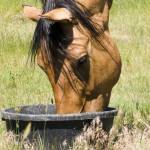Beet Pulp in Horse Feeds: A Brief History

For centuries, root fodders, such as carrots, swedes (turnips), potatoes, and fodder beets (known as mangel-wurzel, from the German Mangoldwurzel), have been fed to horses.
The existence of fodder beets was first recorded in the Middle East, and they were fed to cattle in ancient Greece having been used as long ago as 500 B.C. The use of fodder beets as livestock feed spread further into Europe in the Middle Ages. In Germany, many varieties of fodder beets were developed. One strain with white flesh was found to be particularly high in sugar, and the “zuckerrube” or sugar beet was developed from that strain.
In the early 1800s, to ease the cane sugar shortage caused by the British blockade, Napoleon had 40 sugar beet processing plants built around the country and demanded the cultivation of 68,000 acres. With the increase in cultivation of sugar beets, the amount of byproduct increased. Because there was a history of feeding roots to livestock, disposing of byproducts in this way was the obvious choice, and byproducts were eventually used in Europe as a feedstuff for horses.
In the late 1800s, over 50% of the sugar in Europe came from sugar beets, so there was a ready supply of beet pulp in the northern European countries. In 1860, Stewart, in his book “A Stable Economy” (London, England), mentions the use of “mangold wurzel” as a feedstuff in horses but with no details.
About this time, sugar beet cultivation began in California but was slow to take off. Eventually, it spread east to Utah and Nebraska. After World War II, cultivation revved up in Idaho, Montana, and North Dakota. Feeding beet pulp to horses in the U.S. was not as prevalent as in Europe and restricted to locations of sugar beet production until after the war. By the 1970s and 1980s, however, feeding beet pulp had gained a reputation as an easy method of putting weight on hard keepers.
A handful of states in the U.S. grow sugar beets, but beet pulp is available almost anywhere in the country.








